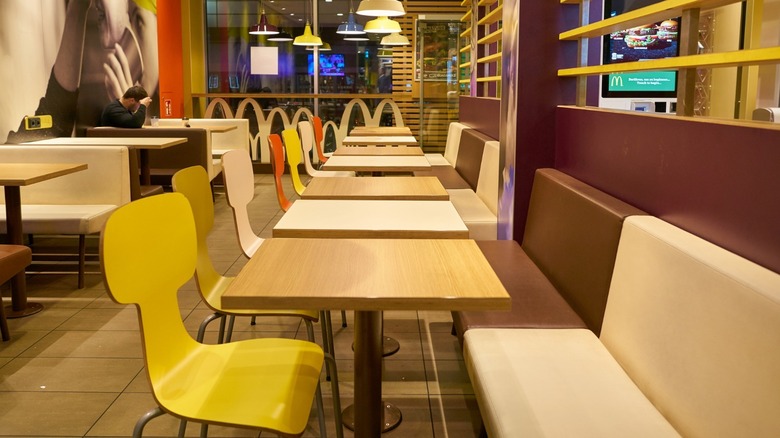Fast Food Restaurants (Like McDonald's) Continue To Ditch Indoor Seating
When is the last time you actually went and sat down for a meal in a fast food restaurant? If you can't remember, it wouldn't be surprising. A lot of people have been opting not to dine in for quite a while. Data from as far back as 2011 suggested that 57% of customers at fast food burger restaurants like McDonald's used the drive-thru (via Chron). But for the 27% of customers who did dine in, there would be bigger changes down the line, and they are now afoot. People are now seeing more self-serve kiosks at fast food restaurants, along with other modern innovations like eateries with no seating and McDonald's quietly opening new stores with robot employees. Those changes are just the beginning of what looks like a big shift.
According to Fast Company, moves towards modernization and efficiency have resulted in more fast food restaurants ditching seating inside their restaurants. Major chains like Taco Bell, Starbucks, and McDonald's have all announced stores with no seating. The focus on drive-thru and curbside pickup only increased during the pandemic, when 70-90% of customers were ordering through the drive-through instead of going into the restaurants themselves (via Restaurant Business). Folks in the restaurant business have touted this shift as a way to save money and increase efficiency, especially as real estate prices continue to soar. But some are worried about the change.
Changes are coming
There are two main concerns we've noticed with fast food ditching the in-restaurant dining experience and relying more on technology like self-ordering kiosks and online ordering. The first is that by reducing the scale of fast food stores, it also reduces the need for employees. Without a dining room, there's no need to have someone who cleans the dining room. With self-ordering kiosks, there's no need for a cashier. Though in the past kiosk companies have insisted that kiosks won't reduce the need for employees, just a few years later they were being touted as a solution to the labor shortage. In the minds of kiosk providers like Ordering Stack, using these machines is not eliminating jobs per se — it's "liberating the workforce from a huge part of their daily duties."
The other concern is that removing seating from fast food restaurants eliminates an affordable gathering space (called "third spaces") for communities that don't have any other place to go. As "Drive-Thru Dreams" author Adam Chandler told Vox, in small towns, they "would see the local Burger King is where a bunch of old timers meet every morning, have coffee and maybe a sandwich, and hang out." But removing seating and employees "speaks to a movement away from those third places." As more and more fast food restaurants do move toward automation and smaller footprints, it will be interesting to see what, if any, third places pop up in communities that need them.

